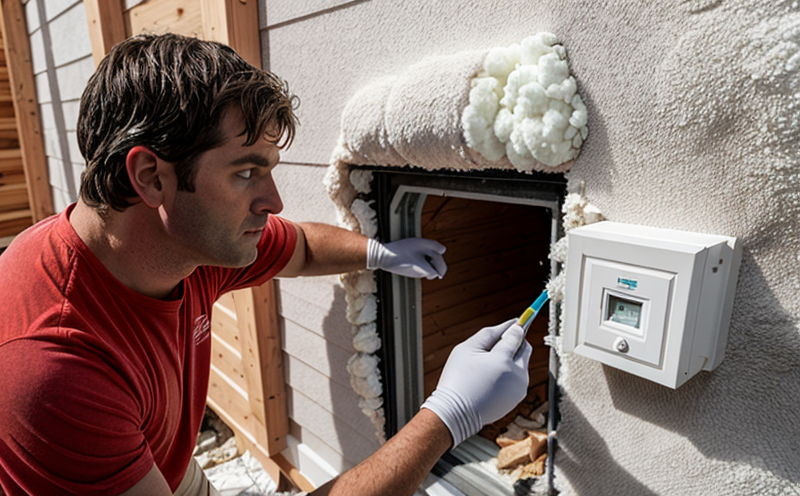ASTM C177 Guarded Hot Plate Evaluation
The ASTM C177 guarded hot plate (GHP) evaluation is a standardized testing method used to determine the thermal insulation properties of materials. This test is particularly relevant for evaluating the thermal performance of insulating boards, blankets, and other similar products in building and infrastructure applications.
This procedure measures the thermal resistance (R-value), also known as the thermal conductivity or heat transfer coefficient, under controlled conditions. The GHP method ensures that a uniform temperature difference is maintained between two sides of an insulated specimen placed on a heated hot plate. Heat flux sensors measure the rate at which energy passes through the material.
The test setup involves placing the insulation sample in a specific orientation and ensuring it is free from air gaps, which could affect the accuracy of results. The apparatus used includes a guarded hot box, which allows for accurate measurement of heat flow across the specimen. This equipment is calibrated according to ASTM C518 or similar standards.
The test method is applicable to various types of insulation materials, including mineral wool, fiberglass, polyurethane foam, and more. It's essential for quality control during manufacturing processes, product development in R&D departments, as well as procurement decisions where thermal performance is critical.
The ASTM C177 GHP evaluation provides valuable data on the thermal efficiency of insulation materials used in various construction projects. Understanding these properties helps architects, engineers, and builders select appropriate materials for achieving desired energy-saving goals without compromising structural integrity or safety standards.
Standardization through this method ensures consistent results across different laboratories worldwide, facilitating easier comparison between products from diverse manufacturers. Compliance with such regulations is crucial for meeting building codes and ensuring sustainable practices in construction industries globally.
- Calibration accuracy: Ensuring precise calibration of all equipment used in the test.
- Environmental factors: Controlling variables like humidity, temperature, and air flow to minimize their impact on results.
- Data analysis: Rigorous statistical methods are employed to interpret collected data accurately.
- Replication consistency: Repeating tests multiple times under identical conditions ensures reliable outcomes.
In summary, the ASTM C177 guarded hot plate evaluation is an indispensable tool for assessing thermal performance in building and infrastructure testing. By providing accurate measurements of insulation properties, this test supports informed decisions that contribute to energy-efficient construction practices while maintaining high standards of quality assurance.
Scope and Methodology
The ASTM C177 guarded hot plate evaluation is designed specifically for determining the thermal resistance (R-value) or heat transfer coefficient of insulating materials. This method applies to various types of insulation including boards, blankets, batts, foams, and other similar products.
During testing, specimens are placed between two heated plates within a controlled environment. One plate is kept at a constant high temperature while the other remains cooler. A heat flux sensor measures the rate at which energy passes through the sample. The difference in temperatures between these two surfaces provides information about how effectively the insulation prevents heat transfer.
To ensure accurate results, strict adherence to ASTM C177 guidelines is necessary throughout every stage of testing from specimen preparation to final data analysis. Specimens must be cut uniformly and free from defects that might affect test accuracy. Environmental conditions such as temperature, humidity, and air movement should also be strictly controlled.
The apparatus used includes a guarded hot box which houses the insulated sample and serves multiple purposes: maintaining consistent boundary conditions around the specimen; providing uniform heating to both sides of the sample; and measuring heat flux across it via embedded sensors. Calibration procedures follow ASTM C518 ensuring precise measurements are made.
This standardized approach guarantees reproducible results regardless of where or by whom they were conducted, making ASTM C177 particularly useful for comparing different materials within a project or between projects from various locations globally.
Quality and Reliability Assurance
- Calibration Accuracy: Regular calibration of all instrumentation involved in the test to maintain accuracy. This includes thermocouples, heat flux sensors, and temperature controllers.
- Environmental Control: Maintaining strict control over environmental variables such as temperature, humidity, and airflow to ensure consistent testing conditions.
- Data Validation: Implementing rigorous statistical methods to validate collected data for consistency and reliability.
- Replication Consistency: Conducting multiple repetitions of the test under identical conditions to verify results.
The ASTM C177 guarded hot plate evaluation is a critical component in quality assurance programs aimed at ensuring that insulation materials meet specified performance criteria. By adhering strictly to established procedures and standards, laboratories can produce reliable data which supports informed decision-making processes.
Regular audits of testing protocols by independent third parties help maintain the integrity of these evaluations. Continuous training for personnel involved in conducting tests ensures they are up-to-date with latest practices and techniques recommended by governing bodies like ASTM International.
Environmental and Sustainability Contributions
The ASTM C177 guarded hot plate evaluation plays a significant role in promoting environmental sustainability within the building and infrastructure sectors. By accurately measuring the thermal resistance of insulation materials, this test aids in selecting high-performance products that contribute to energy-efficient buildings.
Energy efficiency is one of the key drivers behind sustainable construction practices worldwide. Insulation serves as an important barrier against heat loss or gain, reducing heating and cooling demands thereby lowering overall operational costs for occupants. When properly specified based on reliable testing like ASTM C177, materials can significantly reduce carbon footprints associated with building operations.
Furthermore, the results from this evaluation contribute valuable insights into material behavior under real-world conditions which helps drive innovation in product development towards more eco-friendly alternatives. For instance, manufacturers may use these findings to improve existing formulations or explore new technologies that offer enhanced thermal performance without compromising other desirable attributes like durability or cost-effectiveness.
Beyond individual projects, the broader application of ASTM C177 supports efforts aimed at improving overall building stock efficiency through widespread adoption of best practices. This contributes positively towards achieving global commitments made under frameworks such as the Paris Agreement, which focus on reducing greenhouse gas emissions and combating climate change.





